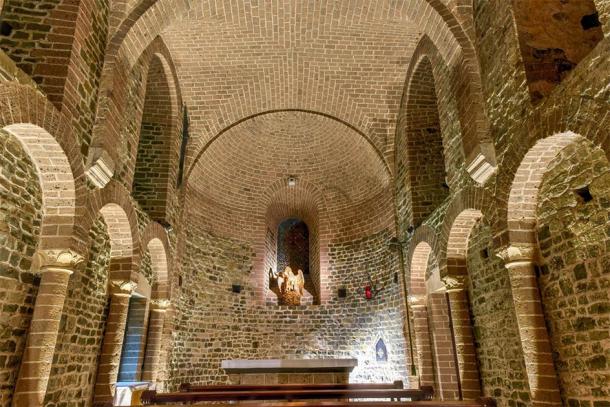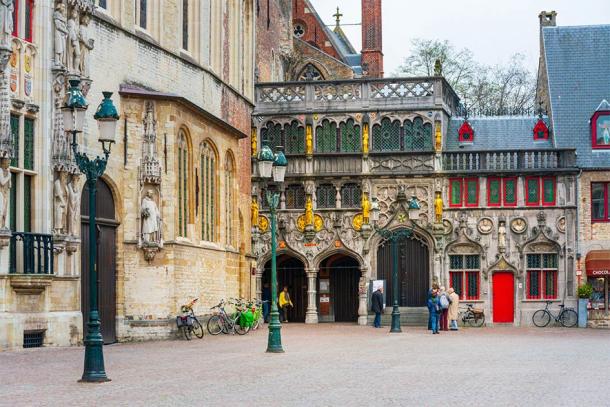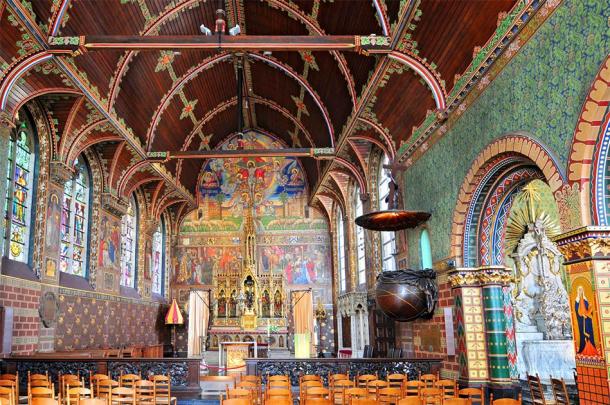
Basilica of the Holy Blood – Does it Really Hold the Blood of Jesus?
The beautiful city of Bruges in Belgium is so well maintained it is said that strolling through town is like walking through a gallery of European architecture. But it’s not only the buildings which bring it fame. The city is home to the Basilica of the Holy Blood, said to hold one of the most venerated relics in all of Christianity – a cloth with the blood of Jesus.
The Basilica of The Holy Blood, Bruges: Crusades and Relics
The earliest fortifications of Bruges date back to the 1 st century AD and it is now famous for its traditional lace works and many historic structures that date to the Middle Ages. The city center is a UNESCO World Heritage site.
The first place of worship was built on this site in approximately 1134 as a private chapel adjacent to the official residence of the Count of Flanders, which now serves as the municipal hall in the city. It is known as the Upper Chapel in the basilica and was built by Thierry of Alsace (1128-1168).
In 1147 the Count of Flanders ‘took the cross’ and joined the Second Crusade. In 1150, it was reported that he returned to the city with a relic of St Basil, a phial that is said to hold a scrap of cloth with the blood of Jesus Christ.

Interior view of the Lower Chapel of the Basilica of the Holy Blood (demerzel21 / Adobe Stock)
People from all over Flanders and beyond visited the basilica, especially after the Pope granted indulgences to anyone who visited the relic, freeing them punishment for their previously committed sins. The Bishop of Bruges presented the phial on certain feast days. During the Wars of Religion in the 16 th century, the relic was protected because it was feared that Protestant iconoclasts would attack the phial.
The basilica was extended in the 16 th century. During the French Revolution, the city of Bruges was occupied by revolutionary forces and the basilica was badly damaged. In the 19 th century, the basilica was renovated in the neo-Gothic style and in 1923 the basilica was granted the status of a minor Cathedral.
The Story of The Blood of Christ
The Holy Blood refers to the blood of Jesus Christ which, according to some apocryphal gospels, was collected by Joseph of Arimathea after Jesus was taken down by from the cross. The blood of Jesus is therefore of great significance in the Christian faith.
It is believed that the King of Jerusalem gave the phial of blood to the Count of Flanders. However, it is more likely the relic was obtained by Count Baldwin IX during the notorious Fourth Crusade, which ended in the sack of Constantinople.
The phial that contains the blood has never been opened and experts believe that the phial is an 11 th century AD Byzantine perfume bottle which casts doubts on the authenticity of the relic. It is held in a special case and shown to the public every Friday, as well as daily from the 3rd to the 17th of May.
Ancient Architecture Basilica of the Holy Blood
The lower chapel, dedicated to St Basil the Great, is a Romanesque structure. The chapel has two side naves adjacent to a central nave which leads to a circular apse, a semi-circular recess under a dome. The lower chapel has remained virtually unchanged.
- 13th Century Pont des Trous Bridge Demolished: Archaeological Vandalism or Economic Progression?
- The Blood of Saint Januarius and The Miracle of Liquefaction
- The Hippie Town of Calcata - Hiding-Place of the Holy Foreskin of Christ

Exterior view of the ornate Basilica of the Holy Blood in Bruges, Belgium (ilolab / Adobe Stock)
In the right nave is a famous wooden sculpture of a Madonna and infant Jesus, which is beautifully painted. A sculpture of St Basil stands near the entrance.
The upper chapel was originally built in the Romanesque style but was rebuilt in the Gothic style in the 1500’s. It was reconstructed in the Gothic revival style in the 19 th century after it was damaged due to consequences of the French Revolution. This chapel holds the relic of the blood of Christ and is lit by magnificent stained-glass windows.

Interior of Basilica of the Holy Blood in Bruges, Belgium (Cezary Wojtkowski / Adobe Stock)
Behind the altar, which has alabaster figures depicting the Last Supper, is a mural of the Trinity and scenes relating to the Holy Blood and Passion of Jesus. The relic is kept in a small glass cylinder and stored in a spectacular silver tabernacle. A fine marble altar that dates from the 17 th century stands to the side of the main altar. Several statues of the Counts of Flanders and other notables are on display in the upper chapel.
How to visit the Basilica of the Holy Blood, Bruges
The Basilica is in the heart of historic Bruges and there are many important and fascinating landmarks in the general area. It is still a place of worship and mass is celebrated here daily. A fee is charged to enter the Basilica and appropriate attire is recommended. A museum on site holds many interesting relics and artifacts that date back to the 11 th century.
Top image: Relic of the Holy Blood, Bruges.
Source: CC BY SA-2.0
By Ed Whelan
References
Beernaert, B., & Desimpelaere, W. (2001). Bruges, Belgium. Management of Historic Centre, editado por Robert Pickard, 8-30
Begg, D., & Begg, E. (2008). In Search of the Holy Grail and the Precious Blood: A Travellers' Guide. iUniverse
Brown, A. (2007). Perceptions of relics: Civic religion in late medieval Bruges. In Images of Medieval Sanctity (pp. 181-205). Brill
Available at: https://brill.com/view/book/9789047420682/Bej.9789004160538.i-286_009.xml
















Comments
Hello Ed,
This is certainly and interesting article Ed you have here thanks for sharing this piece. What too say, what too say about this topic?
It was for those practices of the Mother Church of the Land displaying supposed Holy Relics and the selling of Indulgences as to why Martin Luther nailed his 95 Thesis on the Church Doors coincidentally on All Saint's Day.
I'd be doubtful in this case because Christ taught his followers to watch out for False Prophets & False Teacher's; The Lord forewarned us that if so, they could deceive, the Very Elect.
So no I'm not inclined to believe the claim of Christ blood in Basilica of The Holy Blood after all it was Christ who says Take Heed that No Man Deceive you; because if so they could deceive the very Elect.
For the record Matthew chapter 24, Christ makes that point 4 Time's over in the passage.
Hey this was a great article Ed that you've written thank you for sharing about Basilica of The Holy Blood much appreciated so until next time Goodbye!
Sigh!